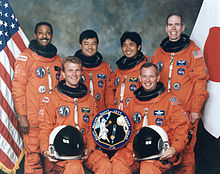STS-72
This article includes a list of references, related reading, or external links, but its sources remain unclear because it lacks inline citations. (May 2008) |
| COSPAR ID | 1996-001A |
|---|---|
| SATCAT no. | 23762 |
| End of mission | |

 | |
STS-72 was a Space Shuttle Endeavour mission to capture and return to Earth a Japanese microgravity research spacecraft known as Space Flyer Unit (SFU). The mission launched from Kennedy Space Center, Florida on January 11, 1996.
Crew
- Brian Duffy (3), Commander
- Brent W. Jett (1), Pilot
- Leroy Chiao (2), Mission Specialist 1
- Winston E. Scott (1), Mission Specialist 2
- Koichi Wakata (1), Mission Specialist 3 - JAXA
- Daniel T. Barry (1), Mission Specialist 4
Mission parameters
- Mass:
- Orbiter liftoff: 112,182 kg
- Orbiter landing: 98,549 kg
- Payload: 6,510 kg
- Perigee: 185 km
- Apogee: 470 km
- Inclination: 28.4°
- Period: 91.1 min
Space walks
- Chiao and Barry - EVA 1
- EVA 1 Start: January 15, 1996 - 05:35 UTC
- EVA 1 End: January 15, - 11:44 UTC
- Duration: 6 hours, 09 minutes
- Chiao and Scott - EVA 2
- EVA 2 Start: January 17, 1996 - 05:40 UTC
- EVA 2 End: January 17, - 12:34 UTC
- Duration: 6 hours, 54 minutes
Mission highlights
The primary objective of the STS-72 mission was to capture and return to Earth a Japanese microgravity research spacecraft known as Space Flyer Unit (SFU). The 7,885 lb (3,577 kg) SFU spacecraft was launched by Japan's National Space Development Agency (NASDA) from Tanegashima Space Center in Japan at 8:01 UT on March 18, 1995 aboard a Japanese H-II rocket (HII-3).

The STS-72 mission also deployed (for about 50 hours) and then retrieved the Office of Aeronautics and Space Technology Flyer (OAST-Flyer) spacecraft. OAST-Flyer was the seventh in a series of missions aboard reuseable free-flying Spartan carriers. It consisted of four experiments: Return Flux Experiment (REFLEX), Global Positioning System Attitude Determination and Control Experiment (GADACS), Solar Exposure to Laser Ordnance Device (SELODE) and the Amateur Radio Association at the University of Maryland (W3EAX) Spartan Packet Radio Experiment (SPRE).
Other experiments onboard STS-72 included the Shuttle Solar Backscatter Ultraviolet Experiment (SSBUV-8) (previously flown on STS-34, STS-41, STS-43, STS-45, STS-56, STS-62 and STS-66), EDFT-03, Shuttle Laser Altimeter Payload (SLA-01/GAS(5)), VDA-2, National Institutes of Health NIH-R3 Experiment, Space Tissue Loss Experiment (STL/NIH-C), Pool Boiling Experiment (PBE) (hardware previously flown on STS-47, STS-57 and STS-60) and the Thermal Energy Storage (TES-2) experiment (previously flown on STS-69).
Get Away Special payloads included the United States Air Force Academy G-342 Flexible Beam Experiment (FLEXBEAM-2), Society of Japanese Aerospace Companies' G-459 - Protein Crystal Growth Experiment and the Jet Propulsion Laboratory GAS Ballast Can with Sample Return Experiment.
Endeavour's 10th flight also included two 6.5 hour spacewalks by three astronauts to test hardware and tools to be used in the assembly of the International Space Station starting in late 1997. EVA-1 on flight day five consisted of Crewmembers Leroy Chiao (EV1) and Dan Barry (EV2) while EVA-2 on Flight Day 7 consisted of Leroy Chiao (EV1) and Winston Scott (EV2).
Documentary
The crew of STS-72 and their families were followed by a camera crew from PBS from the day they were assigned to the flight and then through their training and, finally, the mission itself. The result was a 90 minute documentary narrated by Bill Nye titled 'Astronauts' which first aired on PBS on July 17, 1997 and was later released on VHS home video.
See also
- Spartan Packet Radio Experiment
- Space science
- Space shuttle
- List of space shuttle missions
- List of human spaceflights chronologically

